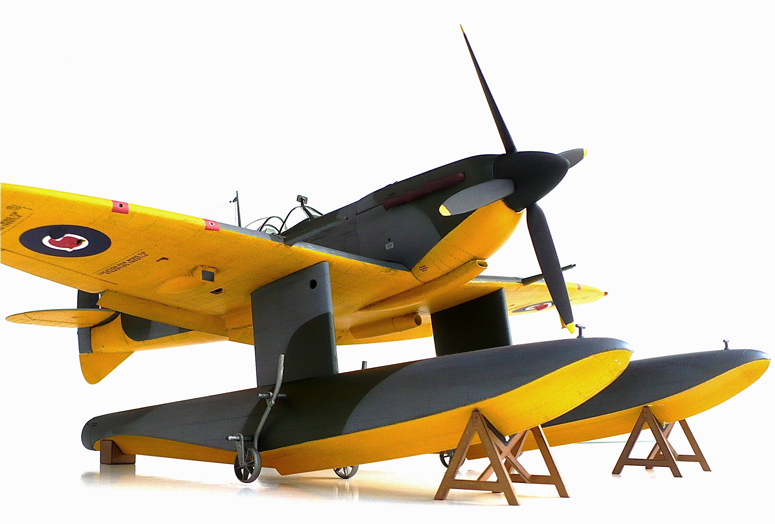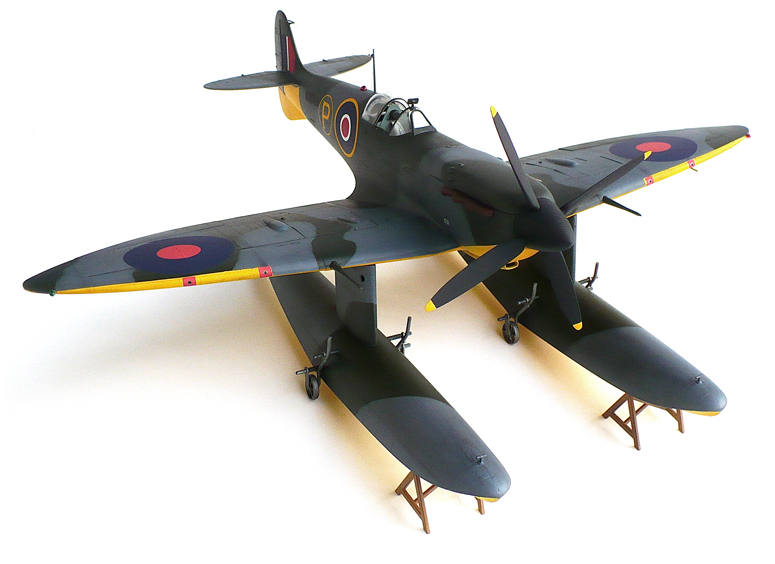
"Supermarine Spitfire Mk, Vb Float Plane " Topic
4 Posts
All members in good standing are free to post here. Opinions expressed here are solely those of the posters, and have not been cleared with nor are they endorsed by The Miniatures Page.
Please don't call someone a Nazi unless they really are a Nazi.
For more information, see the TMP FAQ.
Back to the WWII Aviation Gallery Message Board
Areas of InterestWorld War Two in the Air
Featured Recent Link
Featured Showcase Article
Featured Profile Article
Featured Book Review
|
Please sign in to your membership account, or, if you are not yet a member, please sign up for your free membership account.
| Tango01 | 04 May 2014 10:32 p.m. PST |
"With the German invasion of Norway in April 1940 the RAF took an interest in the concept of using floatplane fighters in areas where airfields were not immediately available. To this end a Spitfire Mk I R6722 was taken in hand at the Woolston factory to be modified and mounted on Blackburn Roc floats. Tank tests were carried out at Farnborough, using a 1/7 scale model, it was found that the concept was basically sound, although the vertical tail surfaces would need to be enlarged to counterbalance the side area of the floats. The end of the Battle of Norway and the need for as many Spitfires as possible meant that R6772 was converted back to an ordinary fighter without being flown
With the entry of Japan into the war the concept was revived in early 1942. A Spitfire V W3760 was fitted with a pair of floats 25 ft 7 in (7.8 m) long, mounted on cantilever legs. This aircraft was powered by a Merlin 45 driving a four-bladed propeller of 11 ft 3 in (3.43 m) diameter (3.4 m). A Vokes filter was fitted to the carburettor air intake and under the tail an extra fin extension was added. Other changes included external lifting points forward of and behind the cockpit and a spin-recovery parachute with a rudder balance-horn guard. The Spitfire floatplane was first flown on 12 October 1942 by Jeffrey Quill. Soon afterwards the Vokes filter was replaced by an Aero-Vee filter, similar to that on later Merlin 61 series aircraft, which was extended to prevent water entry, and full Mk VB armament was installed. Two more VBs EP751 and EP754 were converted by Folland and all three floatplanes were transported to Egypt, arriving in October 1943. At the time it was thought that the floatplanes could operate from concealed bases in the Dodecanese Islands, disrupting supply lines to German outposts in the area which relied on resupply by transport aircraft. This scheme came to naught when a large number of German troops, backed by the Luftwaffe, took over the British held islands of Kos and Leros. No other role could be found for the floatplane Spitfires, which languished in Egypt, operating from the Great Bitter Lake. Specifications for the VB based floatplane included a maximum speed of 324 mph (521 km/h) at 19,500 ft (521 km/h at 5,943 m), a maximum rate of climb of 2,450 ft/min at 15,500 ft (12.45 m/s at 4,724 m) and an estimated service ceiling of 33,400 ft (10,180 m)
In the spring of 1944, with the prospect of use in the Pacific Theatre, a Spitfire IX MJ892 was converted to a floatplane. This used the same components as the earlier Mk VB conversions…"
From wiki.




From here.
link Hope you enjoy!. Amicalement
Armand |
 Doms Decals Doms Decals  | 05 May 2014 3:58 a.m. PST |
Nice, thanks. I've always had a soft spot for the Wildcatfish, so I'm surprised I've not come across this before. |
| Ron W DuBray | 05 May 2014 8:07 a.m. PST |
spitfire returning to its roots :) |
| Tango01 | 05 May 2014 10:18 a.m. PST |
Happy you enjoyed it boys!. (smile). Amicalement
Armand |
|

